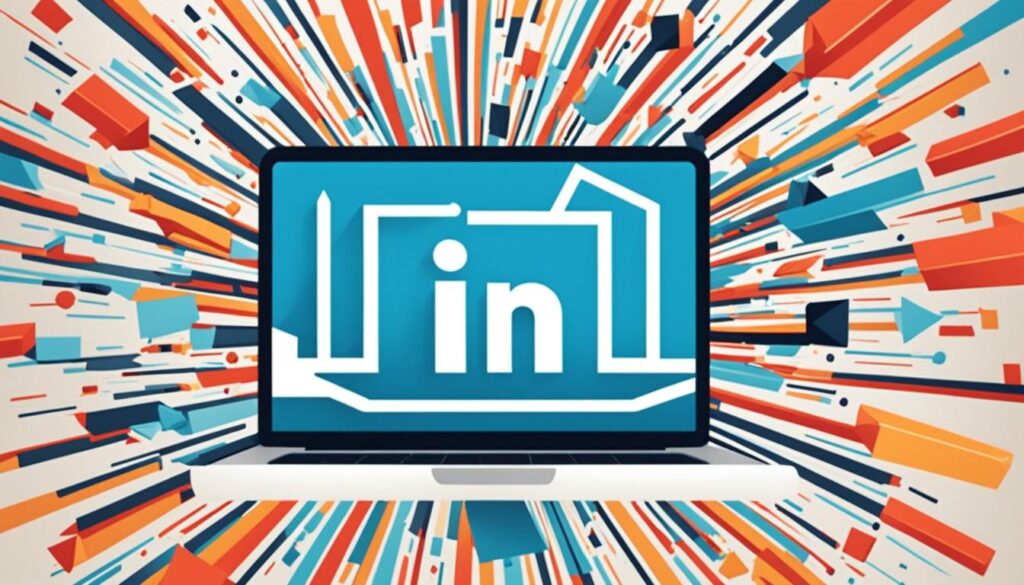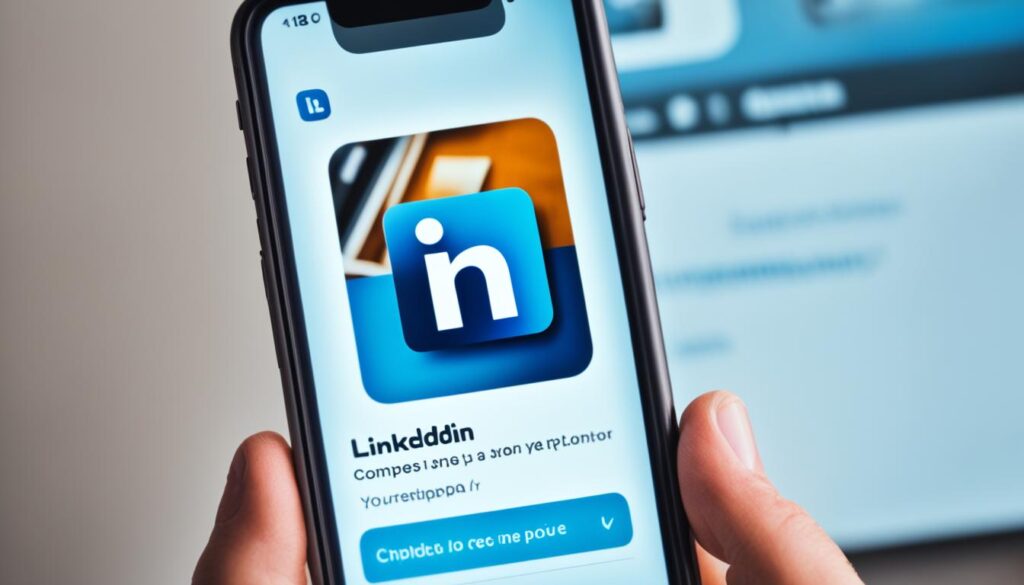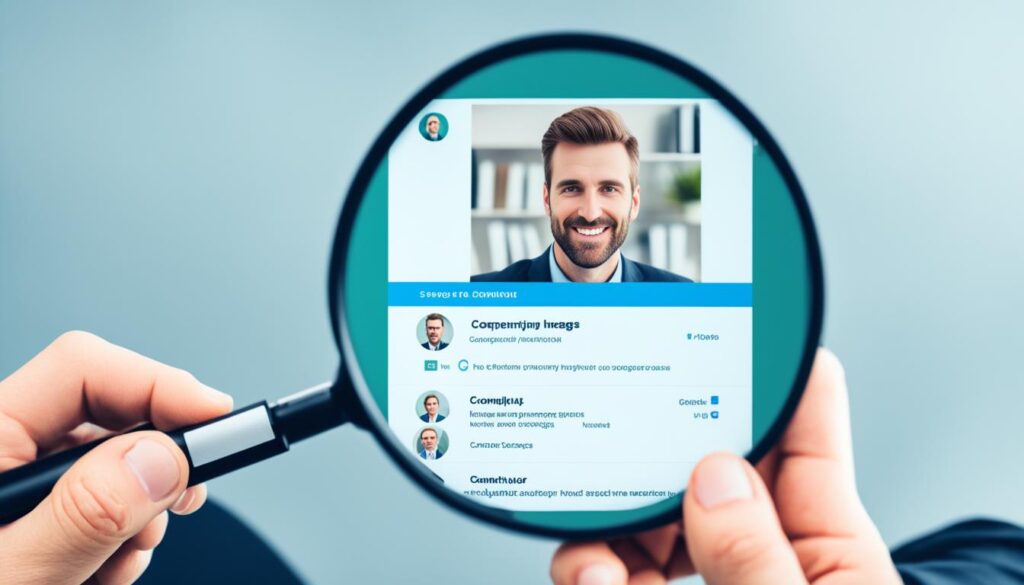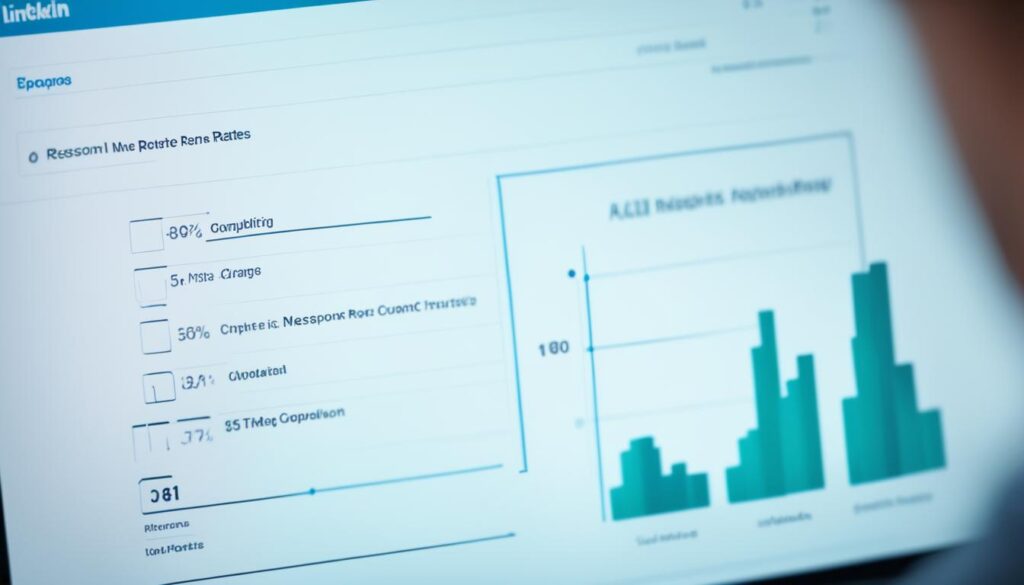As a professional copywriting journalist, I’ve seen how powerful LinkedIn InMail can be. It’s a great tool for making connections and growing professionally. But, you need to use it right to see results. I’m here to share tips on writing the best InMail messages that grab attention and get responses.
Key Takeaways
- Personalized InMails can increase acceptance rates by up to 40%
- Mentioning a common former employer boosts response rates by 27%
- Brevity is key, with InMails under 400 characters seeing 22% higher response rates
- Optimal send times are between 6-8 am on weekdays
- Leveraging InMail analytics can help refine your outreach strategy
In today’s digital world, it’s hard to stand out in a crowded inbox. But LinkedIn InMail can be your edge. It can help you make strong connections, find new chances, and move your career forward. Let’s explore the best practices that will boost your InMail skills.
Introduction
LinkedIn InMail is a powerful tool for professional outreach and networking. It lets you message anyone on LinkedIn, even if you’re not connected. This can be a big advantage, as InMail messages get a high response rate of 18-25%. This is much better than the 3% for regular cold emails.
The Power of LinkedIn InMail for Professional Outreach
LinkedIn InMail lets you connect with many potential clients or candidates. It’s different from regular LinkedIn messages, which are only for people you know. Using InMail, you can get better responses and make important connections in your field.
Overview of LinkedIn InMail Features and Benefits
LinkedIn InMail has many features that help with professional outreach. Some key benefits include:
- Message anyone on LinkedIn, not just your friends
- Get more replies than with regular cold outreach
- Customize your messages for the person you’re sending them to
- Use analytics to see how your InMail is doing
- Get more noticed and respected on LinkedIn
Learning how to write great LinkedIn InMail messages can really help you. It’s a way to make strong connections, find new leads, and move forward in your career.
“LinkedIn InMail is a game-changer for professional outreach. Its higher response rates and personalization capabilities make it an essential tool in any sales or recruitment strategy.”
1. Crafting the Perfect Subject Line
The subject line is key in LinkedIn InMail. It’s what catches the eye first. A good subject line can really help you get a reply. LinkedIn shows short subject lines under 400 characters work best, with 22% higher response rates.
Importance of a Compelling Subject Line
A great subject line opens the door to your message. LinkedIn says it’s the most crucial part of an InMail. It can make or break your chance of getting a reply. A catchy subject line grabs attention and sets the right mood for your message.
Examples of Effective Subject Lines
Great subject lines can change the game for your LinkedIn InMail. Here are some examples that work well:
- A job opportunity from Google for [Recipient’s Name]
- We’re impressed with your [Skill] skills, [Recipient’s Name]
- Entrepreneurial people like [Recipient’s Name] needed to join the [Company] team
Avoiding Common Subject Line Mistakes
Creating the perfect subject line is tough, but avoid these mistakes. LinkedIn data shows short subject lines, under 400 characters, get 22% more replies. Avoid generic or vague subject lines too, as they don’t grab attention.
“Personalization in subject lines can lead to a 50% higher open rate in InMails.”
Make your subject lines short, personal, and focused. This can greatly improve your LinkedIn InMail success and boost your reply rates.

2. Personalizing Your Message
Personalizing your LinkedIn InMail is crucial. LinkedIn says personalized InMails can boost acceptance rates by up to 40%. To make a great InMail, research your recipient and match your message to their interests and needs.
Researching Your Recipient
Before you reach out, research your recipient well. Use LinkedIn for info on their roles, industry, interests, and achievements. This helps you understand what’s important to them and how you can help.
Tailoring Your Message to the Recipient’s Interests and Needs
With the info you’ve found, make a message that talks to their interests and problems. Talk about their career, projects they’ve started, or trends they care about. Showing you know their world well will help you connect better and get a positive reply.
Using the Recipient’s Name and Relevant Details
Personalization is more than just learning about your recipient. Use their name and other details in your InMail. Call them by their first name and show you’ve learned about them. This makes your message stand out.
For effective LinkedIn InMail, be genuine and personal. Research your recipient, customize your message, and use their name and details. This way, you’ll make InMail that gets noticed and leads to real engagement.
3. Providing Value Upfront
When using LinkedIn InMail, focus on giving value right away, not just pitching jobs or opportunities. Offer solutions or insights that match what the recipient needs and likes. This makes you a valuable resource and boosts the chance of a good response.
Offering Solutions or Insights Relevant to the Recipient
Do your homework on your potential connection. Learn about their challenges or what they’re interested in. Then, write your InMail to meet those needs with helpful insights or solutions. This shows you get their situation and you’re a trusted advisor, not just another salesperson.
Sharing Useful Resources or Information
Sharing valuable resources or info is another way to provide value. This could be industry reports, articles, or tools you think they’ll find useful. Giving genuine value can grab their interest and start a meaningful talk.
Avoiding Hard Sells and Focus on Building Relationships
Avoid hard sells in your LinkedIn InMail. Instead, work on building real relationships. Share your knowledge and offer help without expecting anything back. This approach boosts your chance of a positive reply and sets the stage for lasting, beneficial relationships.
By always giving value and focusing on building relationships, you become a trusted partner. This increases your chances of successful LinkedIn outreach. Tools like LeadDelta’s inbox management system can help streamline your outreach.

4. Keeping It Concise and Clear
LinkedIn InMail should be short and clear. Messages under 400 characters get 22% more replies. Write short, engaging messages to grab attention fast.
Avoid using hard words and jargon in your messages. Use a friendly and clear tone. This makes your message easy to understand.
Writing Short, Engaging Messages
Keep your LinkedIn InMail brief. Aim for 400 characters or less. This helps your message get noticed and replied to.
Avoiding Jargon and Complex Language
Don’t use hard words or jargon. Write in a friendly way that’s easy to get. Use simple language to share your message and what you offer.
Getting to the Point Quickly
Make your LinkedIn InMail direct. Skip long introductions. Clearly state your message’s purpose and how you can help the recipient.
“The best LinkedIn InMail messages are short, clear, and to the point. Avoid jargon and complex language, and focus on engaging the recipient with a conversational, enthusiastic tone.”
Follow these tips to make your LinkedIn InMail clear and concise. This way, you’ll get more replies from your audience.
5. Including a Clear Call-to-Action
When you write your LinkedIn InMail, make sure to add a clear call-to-action (CTA). This helps you set clear goals, get the response you want, and make it simple for them to act.
Defining Your Objective Clearly
First, define what you want from the InMail. Do you need advice or opinions? Are you looking for a referral or to set up a meeting? Knowing your goal helps you craft a CTA that fits your needs and tells the recipient what to expect.
Encouraging a Specific Response or Action
After setting your goal, use your CTA to guide the recipient. You might say “I’d love to hear your thoughts on this” or “Can we talk on a 15-minute call next week?” Clear instructions make it easy for them to reply and connect with your message.
Making It Easy for the Recipient to Take Action
Make it simple for the recipient to act. You could add a link to your calendar for scheduling a call. Or, offer to send more info or resources. The easier it is, the more likely they are to respond well to your CTA.
Adding a clear, strong call-to-action to your LinkedIn InMail boosts the chance of getting a positive response. Remember, define your goals, encourage specific actions, and make it easy for them to act.
| Metric | Average |
|---|---|
| LinkedIn InMail CTA Clickthrough Rates | 18-25% |
| Conversion Rates for “Buy Now” or “Complete Purchase” CTAs | 12-18% |
| Engagement Rates on LinkedIn Social Media CTAs | 8-12% |
| Pageviews on Landing Pages with “Download” or “Sign Up” CTAs | 25-35% |
| Bounce Rates on Content Pages Linked Through Email CTAs | 20-30% |
| Impressions of LinkedIn Ads with “Register Now” or “Request Demo” CTAs | 15-25% |
| Leads Generated from Content Download and Event Sign-Up CTAs | 8-12% |
| Open Rates of InMail Messages with CTA-Focused Subject Lines | 22-28% |
These stats show that a clear, strong call-to-action in LinkedIn InMail can greatly improve its impact. It can lead to more engagement from your audience.

“An InMail is 3 times more likely to be accepted than a cold call, and 6 times more likely to be opened than a cold email. Leverage this advantage by including a strong call-to-action that encourages your recipient to take the next step.”
6. Following Up Strategically
Following up on LinkedIn InMail is key to making a big impact. You can’t send direct InMail follow-ups on LinkedIn. But, there are smart ways to keep in touch with your connections and grow your relationships.
Timing Your Follow-Ups Appropriately
When you send follow-up messages, timing matters a lot. LinkedIn says InMails get fewer replies on Thursdays, Fridays, and Saturdays. To get better results, send your follow-ups early in the week. Mondays, Tuesdays, and Wednesdays are best when people are most active on LinkedIn.
Crafting Polite and Persistent Follow-Up Messages
Make your follow-up messages personal. Don’t use the same message for everyone. Show you really care about what your connection does and what they want to achieve. Messages that offer useful info or tips are more likely to get a response.
Knowing When to Move On
Being persistent is good, but know when to move on if someone doesn’t reply. Try following up a few days after your first message to keep things fresh. If you still don’t hear back after a couple of polite messages, it’s time to look for other leads. This way, you use your time and energy wisely.
| 6 Best Tips on How to Follow Up After Connecting on LinkedIn |
|---|
|

“Effective follow-up messages on LinkedIn demonstrate professionalism, commitment, and genuine interest in building relationships.”
7. Leveraging InMail Analytics
As a savvy professional, you know LinkedIn InMail is key for reaching out. But to really make the most of it, you need to use the analytics. By tracking important metrics, you can make your strategy better and get more success.
Tracking Open and Response Rates
LinkedIn’s InMail tools give you data on how many people open and respond to your messages. This lets you see what works with your audience and change your approach. Look at things like your subject lines, what you write, and when you send it to find the best way to connect.
Analyzing Which Messages Perform Best
Using LinkedIn InMail analytics helps you see which messages get the most attention. Look at what makes your top InMails successful, like their tone, call-to-action, and any pictures or files you include. This way, you can use what works best for your networking and finding leads goals.
Adjusting Your Strategy Based on Analytics
LinkedIn InMail analytics are powerful when you use them to improve your outreach. Keep an eye on how you’re doing and adjust based on the data. You might try different subject lines, change how long your messages are, or focus on certain industries or jobs.
The more you use LinkedIn InMail analytics, the better you’ll be at making strong connections, growing leads, and reaching your goals. Embrace this data approach and see your LinkedIn efforts improve greatly.
| LinkedIn InMail Analytics Metrics | Benchmark Rates |
|---|---|
| Open Rates | More than 85% |
| Click-Through Rates | Upwards of 5% |
| Response Rates | 10-25% |

“By continuously monitoring your LinkedIn InMail performance and making data-driven adjustments, you can optimize your campaigns for maximum impact.”
Conclusion
This article has shown us how to make the most of LinkedIn InMail. It gives a clear guide for professionals wanting to boost their outreach. By making subject lines catchy, making messages personal, and sharing useful tips, you can get more replies and make stronger connections.
It’s also key to keep messages short and sweet, around 25-50 words. Tailor your content to the person you’re reaching out to, based on their job or skills. Showing you care about their needs can make a big difference. Asking questions can also help you get more responses.
LinkedIn Sponsored InMail is great for finding new leads. It lets you create custom ads, track results, and use LinkedIn Macros for better targeting. By using these tips, you can improve your outreach, make real connections, and reach your goals on LinkedIn.
FAQ
What are the key benefits of using LinkedIn InMail for professional outreach?
LinkedIn InMail lets you reach out to second and third-degree connections without asking to connect. It has a 18-25% response rate, much higher than cold emails’ 3%. It’s great for sales and recruiters to send messages to anyone on LinkedIn.
What are the best practices for crafting a compelling InMail subject line?
The subject line is crucial in InMail, making or breaking the chance for a reply. Short subject lines under 400 characters get 22% more replies. Good subject lines spark curiosity or reference recent news.
How can I personalize my LinkedIn InMail messages?
Personalizing InMails boosts acceptance rates by 40%. Use the recipient’s background, like past jobs or projects, to make it seem tailored. Use LinkedIn info like group memberships or recent job changes to personalize your messages.
What is the best way to provide value in my LinkedIn InMail messages?
Don’t just pitch a job or opportunity. Offer solutions or insights that match the recipient’s needs or interests. Share useful resources or information. Focus on building relationships, not just selling.
How can I ensure my LinkedIn InMail messages are concise and clear?
Short InMails under 400 characters get 22% more replies. Skip jargon and complex words. Use a friendly, easy-to-understand tone.
What should I include in the call-to-action of my LinkedIn InMail messages?
Add a clear call-to-action, like asking for advice or referrals. This encourages a response and makes it easy for the recipient to act.
How should I approach follow-up LinkedIn InMail messages?
You can’t send InMail follow-ups on LinkedIn. Use emails or LinkedIn messages instead. Time your follow-ups well and be polite but firm. Most replies come within 24 hours or a week, so know when to move on.
How can I use LinkedIn InMail analytics to optimize my outreach strategy?
Use LinkedIn InMail analytics to see open and response rates. Find out which messages work best and adjust your strategy. This data helps you improve your InMail campaigns and success rate.
Source Links
- 10 LinkedIn InMail Best Practices | LinkedIn
- Linkedin Inmail Best Practices: 11+ Tips To Get More Replies
- 10 Best LinkedIn InMail Templates and Best Practices
- What a Strong LinkedIn InMail Looks Like: 4 Areas to Focus On
- Introduction LinkedIn Message Template Guide: Examples, Best Practices, and Tips – ProfitOutreach
- Best LinkedIn InMail subject lines
- 7 LinkedIn InMail Best Practices You Should Know
- 5 InMail Tactics Nonprofits Can Use to Engage Great Talent
- You’ve Got Mail: 6 LinkedIn InMail Best Practices You Should Know
- LinkedIn InMail Messages: 7 Best Practices to Get Replies | Dripify
- InMail LinkedIn : comment ça marche et best practices
- LinkedIn Outreach: 7 Best Practices To Get a Response
- What Is LinkedIn InMail and How it Works | Dripify
- Advanced LinkedIn Messaging Tactics for Sales Professionals
- Writing Skills | SkillsYouNeed
- Life at Home
- Call to Actions: Types, Best Practices & Strategies | LinkedIn Ads
- A Comprehensive Guide to LinkedIn InMail in 2024
- 15 LinkedIn InMail Best Practices and Message Ads Tips to Close More Customers
- 12 LinkedIn InMail Best Practices: Writing InMail Messages – Octopus CRM
- Follow Up LinkedIn Message: How to Write Engaging Messages | Dripify
- 6 Best Tips on How to Follow Up After Connecting on LinkedIn
- 7 LinkedIn InMail Marketing Tactics to Achieve Better Sales
- Unleashing the Power of LinkedIn InMail Marketing: A Strategic Guide
- A complete guide to LinkedIn InMail
- InMail: Linkedin Shares Best Practices to Help Maximize Response Rates
- The Complete Guide to LinkedIn Sponsored Inmail [+ Best Practices]
- 9 Stats That Will Help You Write Better LinkedIn InMails
